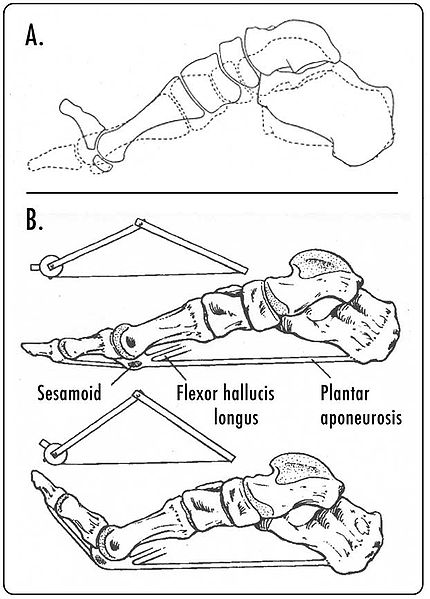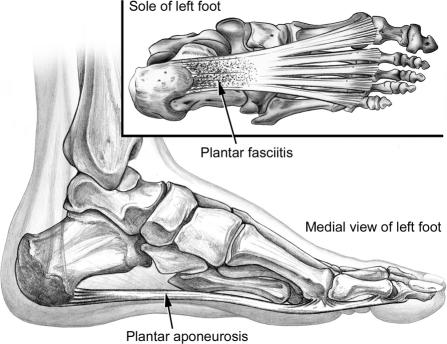Even if you’re not even sure what the windlass mechanism is, your feet are employing it every day. Or at least you should hope your feet are employing it, since an improperly activated windlass mechanism can leave you in pain, unstable, exhausted and plagued by agonizing foot problems.
What the Heck is the Windlass Mechanism?
The windlass mechanism is one of those handy biomechanical functions your body automatically activates to ensure proper functioning. This particular mechanism, first described by John Hicks in 1954, involves the functioning of your foot during a walk or run.¹ Unlike earlier bipeds that had flatter, less supple feet, modern man’s feet evolved to accommodate and properly support long distance walking and running in drier and more open environments.²

Figure 1 Source: http://en.wikipedia.org/wiki/File:PF-PlantarMove.jpg
The windlass mechanism involves the rising of the foot’s arch and the subsequent tightening of your foot and compacting of its bones as your take a step to move forward (Figure 1).³ This allows the foot to function as a shock-absorber when your heel hits the ground and then switch to function as a rigid lever that helps propel you forward for your next step.²,⁴ A properly activated windlass mechanism gives you the stability you need to effectively walk, run, bicycle or engage in other activities that involve your feet.
The flattening of your arch and stretching of the plantar aponeurosis during the mechanism also saves you loads of energy (Figure 2). One study gauged the energy savings at more than 15 percent higher than those who walk or run without a properly activated windlass mechanism.⁵ The energy savings comes from the foot’s ability to store energy as it flattens, or pronates. That energy is then released when the foot arches, or supinates, and we are propelled forward from the elastic properties in the foot’s arch that act as a spring mechanism which instantly jump into action without any conscious muscle activation on our part.⁶

Figure 2. The plantar aponeurosis originates from the base of the calcaneus and extends distally to the phalnages. Source: http://www.ncbi.nlm.nih.gov/pubmed/16558682
What Can Go Wrong
Expending unnecessary energy during a walk or run is not the only drawback that can result when the windlass mechanism is not properly activated. If your foot no longer transforms into the rigid lever needed to help propel your forward, it can mess up your gait’s timing and effectiveness along with your overall body mechanics.
On the flipside, if your foot is stuck in supination as a rigid lever, it will be unable to flatten the arch. This leaves your foot unable to absorb shock or store energy through elastic recoil. Either scenario can put undue repetitive stress on your fascia, resulting in tears in the plantar fascia and the painful condition of plantar fasciitis.⁷
Risks of a windlass mechanism that is delayed in its activation include poor stabilization of your midfoot area and more tension on the ligaments throughout your foot. Delayed activation can result in overuse injuries, joint subluxation and more of that aforementioned pain.³
Making It Right
The treatment of heel pain, plantar fasciitis and instability due to an improperly activated windlass mechanism involves going to the source of the problem. Instead of merely treating the physical symptoms, treating the root cause of the issue can not only help eliminate symptoms but also ensure proper functioning going forward. The windlass mechanism relies on the dorsiflexion of the big toe, which is the extension of the toe back toward the body. Thus adding controlled dorsiflexion of the toe to a recovery program that additionally stretches the calf muscles can help reduce symptoms and restore biomechanics to their optimum functioning.
A Pilates practice that focuses on stretching and strengthening the foot and ankle complex can also help. Keeping the muscles, tendons and ligaments of your feet and ankles strong and supple may not only assist in restoring and maintaining a properly activated windlass mechanism, but additionally ensure your body enjoys proper functioning and stability in a wide scope of activities.
REFERENCES
- Hicks, J. H. The mechanics of the foot II. The plantar aponeurosis and the arch. J Anat. 1954;88:25-31.
- Vereecke E, Aerts P. The mechanics of the gibbon foot and its potential for elastic energy storage during bipedalism. J Exp Biol. 2008;211:3661-3670.
- Kappel-Bargas A, Woolf R, Cornwall M, McPoi T. The windlass mechanism during normal walking and passive first metatarsalphalangeal joint extension. Clin Biomech. 1998;13(3):190-194.
- Donatelli RA. The Biomechanics of the Foot and Ankle. 2nd ed. Philadelphia: F.A. Davies; 1996.
- Bolgla L, Malone T. Plantar Fasciitis and the Windlass Mechanism: A Biomechanical Link to Clinical Practice. J Athl Train. 2004;39(1):77-82.
- Ker RF, Bennett MB, Bibby SR, Kester RC, Alexander R. The spring in the arch of the human foot. Nature. 1987;325(8): 147-149.
- Cheng H, Lin C, Chou S, Wang H. Nonlinear Finite Element Analysis of the Plantar Fascia Due to the Windlass Mechanism. Foot Ankle Int. 2008;29(8):845.
